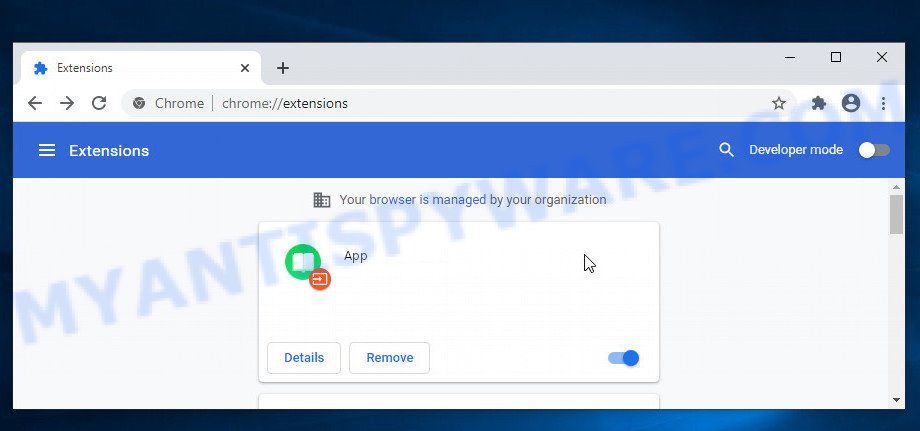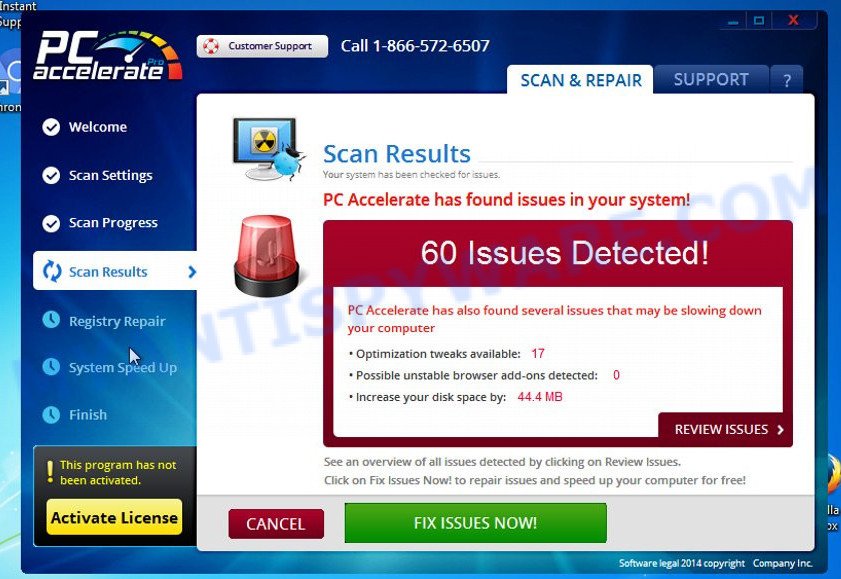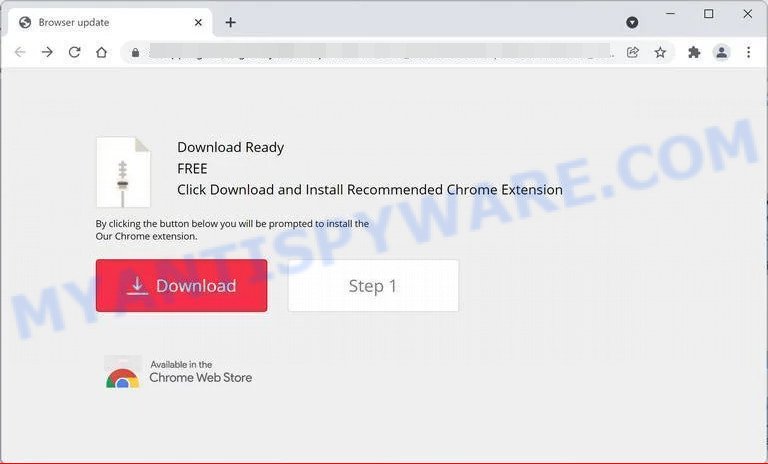Ninja Browser is a Potentially Unwanted Application (PUA) that targets your computer. This app can track your data and act like adware, showing unwanted ads or causing redirects. It might also change your browser settings, like your homepage or search engine, to promote fake search engines. Some PUAs can use your computer’s power for crypto mining or download more unwanted stuff onto your device.
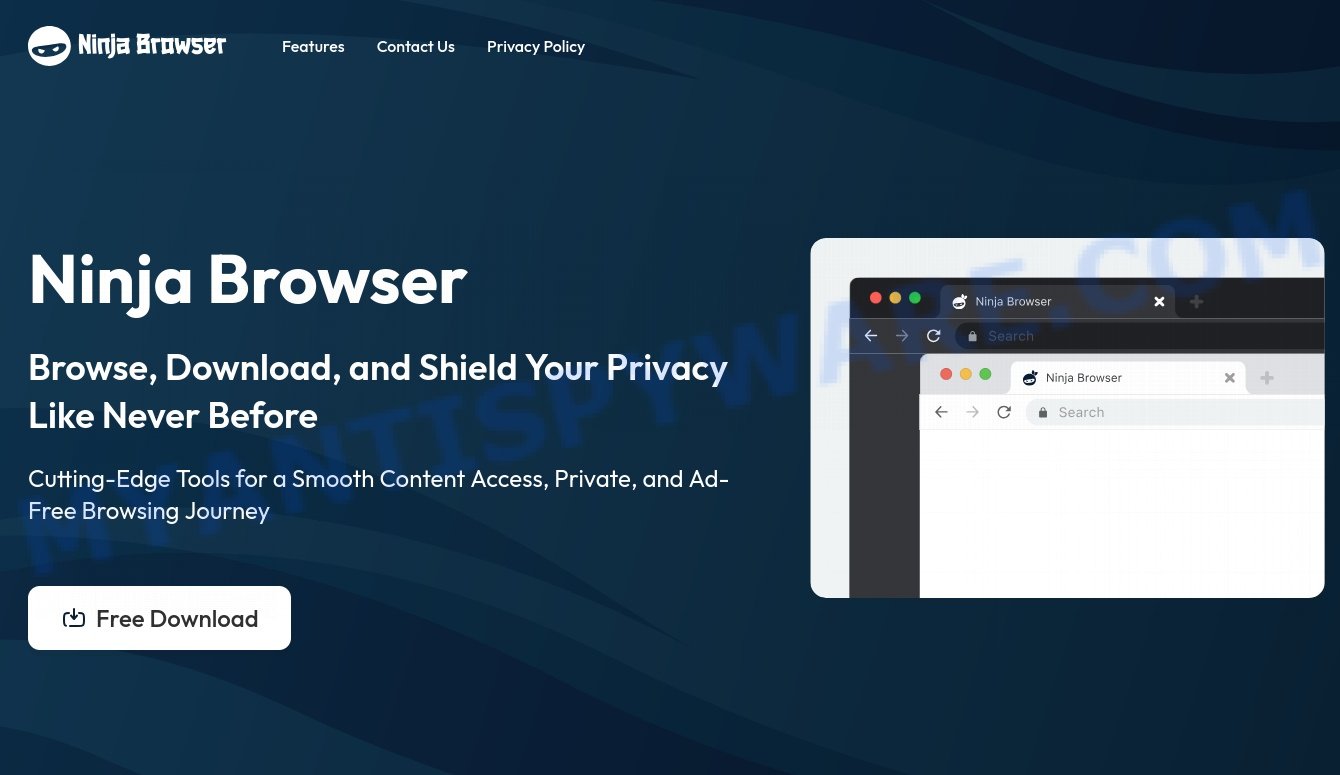
Ninja Browser claims to be an all-in-one tool for browsing, downloading, and keeping your activities private. It promises no ads and safe browsing. But, we found it forces users to use potterfun.com as a search engine. If you search using the address bar, it redirects you through different sites to land on potterfun.com. Potterfun.com isn’t reliable; it may show misleading results and ads, exposing users to scams, phishing sites, and other threats.
Ninja Browser might also gather info such as your location, browsing history, device details, login data, visited websites, and financial info, potentially risking your privacy.
The websites linked with Ninja Browser aren’t trustworthy, and the app itself poses risks. Avoid using it and think about removing it if it’s already on your device for your security and privacy.💡 If you think you have Ninja Browser, follow the steps below to remove it and protect your computer as soon as possible.
Table of Contents
What is Ninja Browser?
The Ninja Browser is a Potentially Unwanted Application (PUA) that poses certain risks to users’ privacy and computer security. It’s important for users to be aware of these risks and consider removing the application if it is installed on their system.
VirusTotal flagged Ninja Browser as malicious (installer):
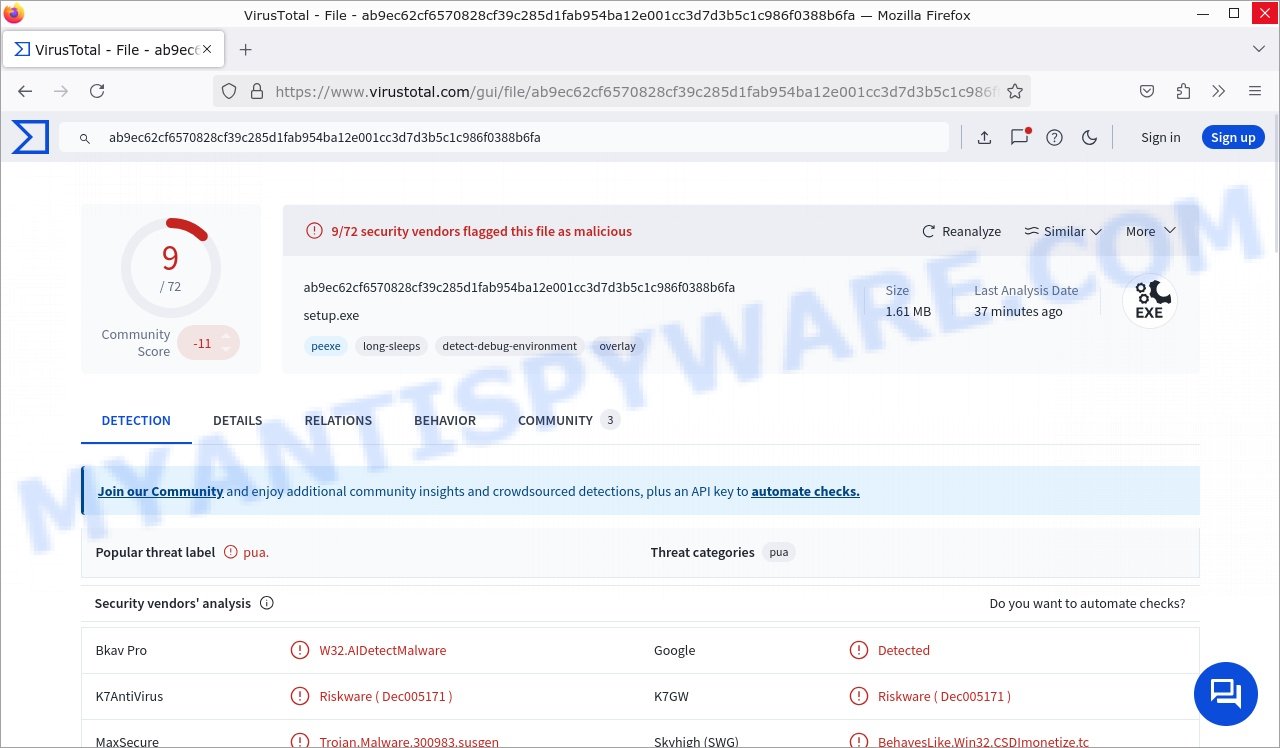
Ninja Browser can change your browser settings without permission, including altering your homepage, default search engine, and new tab settings. It directs search queries through questionable engines like potterfun.com via intermediaries such as x-finder.pro and search-more.com, potentially exposing users to misleading results and unwanted advertisements.
Risks and Consequences:
- Ninja Browser might gather various types of personal information, including location data, browsing history, device details, and potentially even login credentials and financial information.
- The browser is associated with redirects to unreliable search engines that can display misleading advertisements and lead to scam websites. These sites may attempt to trick users into downloading more unwanted software or falling for phishing attempts.
- Users redirected to these questionable websites might be exposed to scams such as technical support scams, fake giveaways, and lotteries, potentially leading to financial loss or further privacy breaches.
- VirusTotal and other cybersecurity platforms have flagged the Ninja Browser installer as malicious, associating it with “BehavesLike.Win32.CSDImonetize.tc” and other Malware/Trojan detections.
To remove Ninja Browser, you should uninstall it from your system’s control panel, reset your browser settings to their original state, and consider running a full system antivirus scan to ensure no residual elements of the application remain. It’s also advisable to be cautious about what you download and install to prevent similar issues in the future.
Threat Summary
| Names | Ninja Browser, Ninja Browser.exe |
| Type | PUA (Potentially Unwanted Application), PUP (Potentially Unwanted Program) |
| Affected Browser Settings | home page, search provider, newtab URL |
| Detection Names (installer) | BehavesLike.Win32.CSDImonetize.tc, W32/ABRisk.JSBY |
| Distribution | Misleading pop-up ads, freeware installers (bundling) |
| Symptoms | Unwanted changes to browser settings, redirects, ads |
| Risks | Privacy invasion, system security compromise, fraud |
| Removal | Use the Ninja Browser removal guide |
Malware examples
Malware is a constant threat to computer security, and it comes in many different forms. Some malware can steal your personal information, while others can take control of your computer or encrypt your files and demand a ransom. It’s important to stay vigilant and protect your computer from these threats. Below, we will list some examples of malware programs that you should be aware of, so that you can take steps to protect your computer from them.
Here are some examples of unwanted programs: FlipPlayer, AutoClicker, AZELIT Math Plugin, Wrop Appq, although, of course, there are many more.
Protecting your computer from malware is essential to keeping your personal data and online accounts safe. By following safe browsing practices, using anti-virus software, and staying up-to-date with the latest security patches, you can reduce your risk of becoming a victim of malware. If you suspect that your computer has been infected with malware, take immediate action to remove it and secure your system.
How to remove Ninja Browser from Windows 11 (10, 8, 7, XP)
If Ninja Browser has made its way onto your Windows computer, it’s crucial to act swiftly. This unwanted app can compromise your browsing experience and security. In the steps ahead, we’ll outline a straightforward process to help you effectively remove Ninja Browser from your system. Let’s get started.
To remove Ninja Browser, perform the steps below:
- Kill Ninja Browser process
- Disable Ninja Browser start-up
- Uninstall any suspicious programs
- Reset Browser Settings
- Scan your computer for malware
Read this section to know how to manually remove the Ninja Browser app. Even if the step-by-step guide does not work for you, there are several free removers below which can easily handle such hijackers.
Kill Ninja Browser process
Press CTRL, ALT, DEL keys together.

Click Task Manager. Select the “Processes” tab, look for “Ninja Browser” then right-click it and select “End Task” or “End Process” option. If your Task Manager does not open or the Windows reports “Task manager has been disabled by your administrator”, then follow the guide: How to Fix Task manager has been disabled by your administrator.

This malware masks itself to avoid detection by imitating legitimate Microsoft Windows processes. A process is particularly suspicious: it’s taking up a lot of memory (despite the fact that you closed all of your applications), its name is not familiar to you (if you’re in doubt, you can always check the program by doing a search for its name in Google, Yahoo or Bing).
Disable Ninja Browser start-up
Select the “Start-Up” tab, look for something suspicious that is the Ninja Browser virus, right click to it and select Disable.

Close Task Manager.
Uninstall any suspicious programs
Check your computer for any suspicious programs or extensions and uninstall them. To do this, go to the Control Panel (on Windows) or Applications (on Mac) and uninstall any programs that you don’t recognize or that you think may be associated with the Ninja Browser app.
|
|
|
|
Reset Browser Settings
If Ninja Browser has altered your browser settings, you should reset them.
Chrome:
- Go to the three vertical dots on the top right corner > Settings.
- Scroll down and click on Advanced.
- Under ‘Reset and clean up’, click on ‘Restore settings to their original defaults’ > Reset.
Firefox:
- Go to the three horizontal lines on the top right > Help.
- Choose ‘Troubleshooting Information’ > Refresh Firefox.
Safari:
- Go to Safari > Preferences > Advanced.
- Check the box next to ‘Show Develop menu in menu bar.’
- From the toolbar, click Develop > Empty Caches.
If these steps do not remove Ninja Browser from your browser, it is recommended to use a trusted antivirus program to scan your computer for any associated malware or viruses.
Scan your computer for malware
It is possible that Ninja Browser came bundled with PUPs (potentially unwanted programs) and other unwanted software. To ensure that your computer is clean, run a full system scan with a reputable antivirus software.
You can automatically get rid of PUAs with MalwareBytes. Malwarebytes is a reputable anti-malware software that is commonly used to remove various types of malware, including unwanted apps like Ninja Browser.
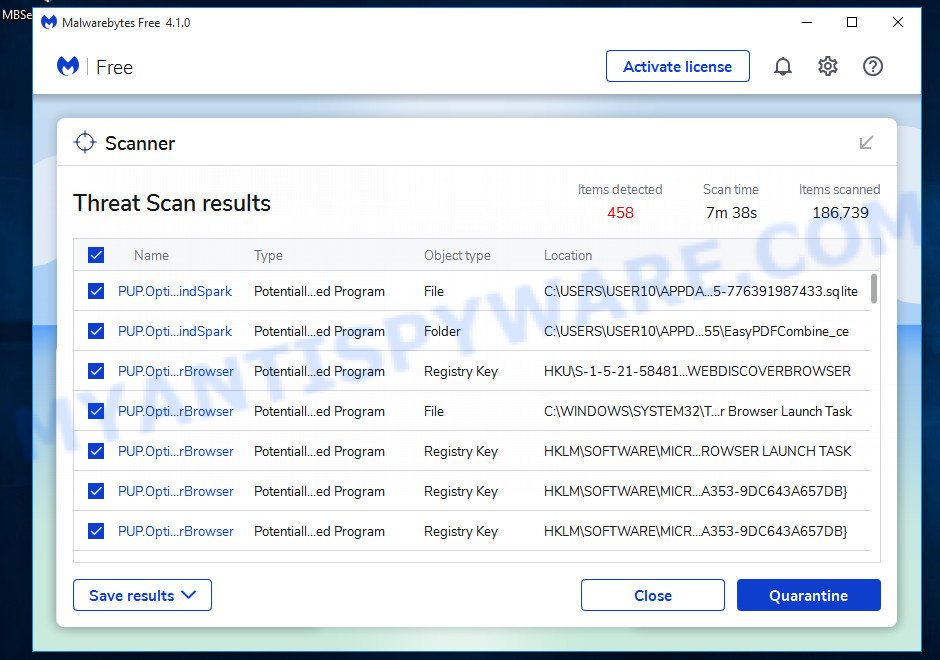
- Download Malwarebytes by clicking on the link below. Save it on your Windows desktop.
Malwarebytes Anti-malware
327067 downloads
Author: Malwarebytes
Category: Security tools
Update: April 15, 2020
- Once the download is done, close all applications and windows on your personal computer. Open a folder in which you saved it. Double-click on the icon that’s named MBsetup.
- Choose “Personal computer” option and press Install button. Follow the prompts.
- Once installation is finished, scan your computer. Run a full scan of your computer to detect and remove any PUAs and other forms of malware. The scan may take several minutes to complete, depending on the size of your hard drive and the speed of your computer.
- Remove detected threats. If the scan finds any threats, click Quarantine to remove them. The software will automatically remove the PUA and any associated malware. After the removal process is complete, restart your computer to ensure that any changes made by the hijacker are fully removed.
The following video demonstrates how to remove hijackers, adware and other malware with MalwareBytes.
What to Do After Removing the PUA
After successfully removing the Ninja Browser app from your computer, it is important to take some additional steps to ensure that your computer and personal information remain secure. Here are some recommended actions to take:
- It’s important to change your browser settings back to your preferred search engine and homepage. Make sure that Ninja Browser is completely removed from your browser’s settings and that it cannot reappear.
- If you entered any sensitive information such as login credentials or passwords while the PUA was active, change them immediately. This will prevent any potential identity theft or unauthorized access to your accounts.
- To remove any traces of the unwanted app, clear your browser history and cache. This will help ensure that any data or information collected by the hijacker is removed from your system.
- Use a reputable anti-malware program like Malwarebytes to scan your computer for any remaining malware or potentially unwanted programs (PUPs). This can help ensure that there are no hidden threats or malicious files on your computer.
- Make sure that your browser and operating system are up-to-date with the latest security patches and updates. This can help prevent future security issues and keep your system protected.
- To avoid getting infected with similar malware in the future, be cautious of downloads and only download from reputable sources. Avoid clicking on suspicious links or downloading attachments from unknown sources.
Conclusion
Ninja Browser is a potentially unwanted app (PUA). This can disrupt your browsing experience and potentially expose your personal and financial information to cyber threats.
Bottom Line: Avoid ignoring signs of suspicious activity such as frequent pop-ups and unexpected page redirects. The best course of action is to promptly clean your browser and system to maintain a secure digital environment. 🛡️💻
Stay cautious about the websites you visit and the programs you install. Regular updates and careful monitoring of your browser and computer settings can greatly minimize the risks of encountering such security issues. 🤔
